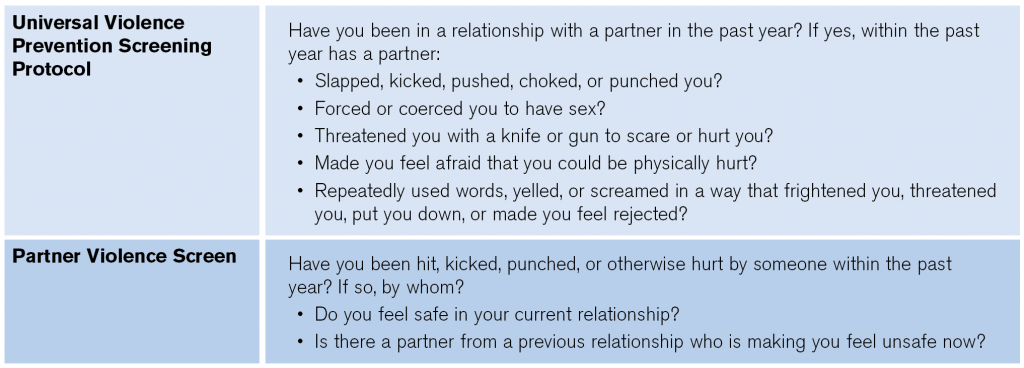
Multiple methods of IPV screening have been studied in the emergency department, including direct questioning, written surveys, and computer-based surveys. Rates of identification are higher with self-administered surveys, whether paper-based or computer-based, than with direct questioning.9 Regardless of the method of screening, it is important to screen in a private location without visitors, including children over the age of two. Use nonjudgmental language, such as, “Because I see so much violence in my practice, I ask everyone these questions.”
Explore This Issue
ACEP Now: Vol 37 – No 08 – August 2018There are several validated IPV screens that may be modified to fit a particular patient’s situation.10 Table 1 has a list of common screening questions.

(click for larger image) Table 1: Common IPV Screening Questions
Source: Rozzi HV, Smale LE. Uncivil union: intimate partner violence. Crit Decis Emerg Med. 2018;32(3):3-9.
Disclosure
If patients disclose that they are a victim of IPV, provide an empathetic response such as, “I’m sorry that happened to you. How can I help?”
For many reasons, not all patients who disclose IPV are able to leave their abusive situations. Many victims of abuse stay for financial reasons. Others fear for themselves, their families, and their pets if they were to leave. Victims are the experts on their own safety, and it is the responsibility of the emergency physician to provide patients with resources and referrals tailored to the individual situation.
In some states, emergency physicians are mandated to report IPV to law enforcement. Emergency physicians should become familiar with the statutes in the jurisdictions in which they practice, and should inform patients of what they are legally required to report so that patients can make informed decisions about what to share with their physician.
Safety Planning
If the screen is positive, the patient requires a safety plan prior to discharge. It is important to know what resources are available in your area for victims of IPV. Depending on your hospital’s policy, social work, forensic nurses, or community IPV organizations may be able to assist with safety planning. Ideally, the IPV advocate should meet with the patient in the emergency department. If the patient declines assistance from the IPV advocate, contact information for community resources should be provided. Many IPV victims store this information in their phones under a fictitious name, as abusers may look at their victim’s contact list.
Case Conclusion
You note the circular injury on the patient’s right cheek (see Figure 1), which appears to be consistent with a bite wound. She also has injuries to the neck (see Figure 2) that are inconsistent with the history provided. When the patient goes to radiology for imaging, her sister is asked to remain in the emergency department. Before the radiology tech comes into the room, you ask the patient, “Many times, injuries like this are caused by another person. Did someone hurt you?” The patient begins to cry as she reveals that her husband punched her repeatedly. She lost consciousness and did not recall what happened after that. She begs that her sister not be told, but she is willing to speak privately with the hospital social worker. Once finished in the emergency department, she plans to take her dog and stay at a friend’s home.
- Universal screening for intimate partner violence is recommended by many organizations, including ACEP.
- For IPV screening to be done routinely, it must be built into the workflow of the emergency department.
- Be prepared with an appropriate response and a management plan if the IPV screen is positive and utilize community resources for safety planning.




No Responses to “How to Help Victims of Intimate-Partner Violence”